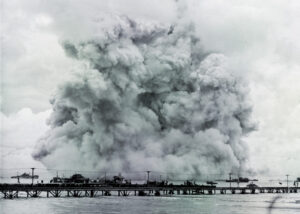The Custom of the Sea, by Neil Hanson (1999) John Wiley & Sons, Inc., New York, New York 10158. 336 pages. $24.95.
“Cast adrift in a tiny boat on a vast and desolate ocean, faced with almost certain death, what would you be willing to do to survive?” Neil Hanson asks readers this question before they plunge into the depths of his new publication The Custom of the Sea, a “shocking true tale of shipwreck, murder and the last taboo.”
Captain Tom Dudley and his crew of three, including two experienced sailors and the young cabin boy, Richard Parker, head for Sidney, Australia, in 1884 aboard the pleasure yacht Mignonette. Squalls and storms beseige Dudley and his crew as they make their way down the coast of Africa, and they do their utmost to keep their aging craft from foundering. Overturned by a freak wave, the Mignonette sinks, and the four find relative safety in the ship’s open 13-foot dinghy. With little food, no water, and no protection from the elements, Tom and his crew are exposed to the harshness of the southern Atlantic Ocean; the sun, the salt, the heat of the day and the chill of the night.
Even after using up their meager rations, being tossed relentlessly by a week of stormy gales, and fighting off circling sharks, the thirsting crew still keep watch over the horizon for the sight of a sail–but find none. They catch a sea-turtle and live on its flesh for over a week. Tom constantly reminds his mates of the danger of drinking sea water and encourages them to fight the urge to slake their thirsts with even the smallest amount.
After eating the last of the food, Tom mentions that the “Custom of the Sea” may have to be put into practice: “If no boat comes soon, we shall have to draw lots.” Richard lies dying in the bottom of the boat, and the other three are weak and can hardly speak. The days slowly pass, and with no appearance of a ship to save them, Tom carves slivers of wood for the drawing of lots. “One must die to save the others,” and this lot falls to Richard. After the group survives off his body for another four days, a vague shape begins to materialize in the mist; the castaways are rescued by the Moctezuma after 24 days adrift.
Nursed by the Moctezuma’s captain’s wife, the three remaining crewmen begin to heal. The public welcomes them upon their return to England, but more suffering awaits. They are arrested for murder and must face the corrupt court system of Victorian England.
Edgar Allen Poe’s 1837 novel The Chronicle of Arthur Gordon Pym of Nantucket eerily presaged this event in almost every detail (even down to the cabin boy’s name). This coincidence inspired Hanson to investigate the true story. His account reads almost like fiction, with so many facts and details cramming its pages. The authentic account of the sinking of the yacht Mignonette and the misery of her crew which followed, both on the sea and on dry land, allows readers a glimpse into the Victorian world of 19th-century England. Amazing facts of the life and work of a British sailor, as well as similar accounts of other ill-fated merchant and Royal Navy ships, punctuate the tale to show the regularity of these incidents. Hanson also indirectly debates the question of justice versus law during the ensuing trial of Tom Dudley and his remaining crew.
In May of 2000, author Neil Hanson talked about this impossible choice, “I hope it provokes you to think about many things–about that varnished world, so close in time and yet so utterly remote from us; about the conflict between justice and the law; about whether to tell the truth is always right…But above all I hope it causes you to ask the question I paused to ask myself many times…what would I have done if it had happened to me?”




